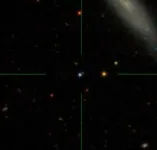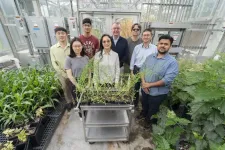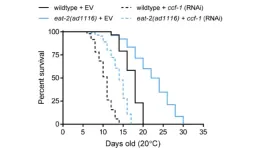(Press-News.org) University of Missouri scientists are peering into the past and uncovering new clues about the early universe. Since light takes a long time to travel through space, they are now able to see how galaxies looked billions of years ago.
In a new study, the Mizzou researchers have discovered that spiral galaxies were more common in the early universe than previously thought.
“Scientists formerly believed most spiral galaxies developed around 6 to 7 billion years after the universe formed,” said Yicheng Guo, an associate professor in Mizzou’s Department of Physics and Astronomy and co-author on the study. “However, our study shows spiral galaxies were already prevalent as early as 2 billion years afterward. This means galaxy formation happened more rapidly than we previously thought.”
This insight could help scientists develop a better understanding of how spiral galaxies such as the Milky Way, Earth’s home galaxy, formed over time.
"Knowing when spiral galaxies formed in the universe has been a popular question in astronomy because it helps us understand the evolution and history of the cosmos," said Vicki Kuhn, a graduate student in Mizzou’s Department of Physics and Astronomy who led the study. "Many theoretical ideas exist about how spiral arms are formed, but the formation mechanisms can vary amongst different types of spiral galaxies. This new information helps us better match the physical properties of galaxies with theories — creating a more comprehensive cosmic timeline."
Using recent images from NASA’s James Webb Space Telescope (JWST), the scientists found that nearly 30% of galaxies have a spiral structure about 2 billion years after the universe formed. The discovery provides a significant update to the universe’s origin story as previously told using data from NASA’s Hubble Space Telescope.
Studying distant galaxies with JWST gives Guo, Kuhn and other scientists an opportunity to solve a cosmic puzzle by determining the meaning of each clue.
“Using advanced instruments such as JWST allows us to study more distant galaxies with greater detail than ever before,” Guo said. “A galaxy’s spiral arms are a fundamental feature used by astronomers to categorize galaxies and understand how they form over time. Even though we still have many questions about the universe's past, analyzing this data helps us uncover additional clues and deepens our understanding of the physics that shaped the nature of our universe.”
“JWST Reveals a Surprisingly High Fraction of Galaxies Being Spiral-like at 0.5 ≤ z ≤ 4,” was published in Astrophysical Journal Letters. Additional co-authors are Alec Martin, Julianna Bayless, Ellie Gates and AJ Puleo. This project was supported by University of Missouri Research Council grants and the Missouri Space Grant Consortium.
This study was presented by Kuhn at the 244th meeting of the American Astronomical Society in Madison, Wisconsin.
END
Mizzou scientists spot more Milky Way-like galaxies in early universe
The study advances our understanding of how galaxies were formed.
2024-06-11
ELSE PRESS RELEASES FROM THIS DATE:
How do supermassive black holes get super massive?
2024-06-11
UNIVERSITY PARK, Pa. — By combining forefront X-ray observations with state-of-the-art supercomputer simulations of the buildup of galaxies over cosmic history, researchers have provided the best modeling to date of the growth of the supermassive black holes found in the centers of galaxies. Using this hybrid approach, a research team led by Penn State astronomers derived a complete picture of black-hole growth over 12 billion years, from the Universe’s infancy at around 1.8 billion years old to now at 13.8 billion years old.
The research comprises two papers, ...
Pilot study in JNCCN explores new approach for reducing anxiety and improving quality of life after stem cell transplantation
2024-06-11
PLYMOUTH MEETING, PA [June 11, 2024] — New research in the June 2024 issue of JNCCN—Journal of the National Comprehensive Cancer Network highlights a promising approach for alleviating distress, enhancing quality of life, improving physical function, and reducing fatigue in patients with blood cancers who undergo hematopoietic stem cell transplantation (HSCT). The study used a randomized clinical trial to evaluate the feasibility of a nine-week, phone-delivered, positive psychology program called Positive Affect for the Transplantation of ...
Controlling the precise timing of electrical pulses may offer promise for treating mild traumatic brain injury
2024-06-11
An awkward beat doesn't help on the dance floor, but it could help people who are recovering from mild traumatic brain injury (mTBI).
Publishing online today (June 11, 2024) in the Journal of Neurotrauma, Virginia Tech scientists with the Fralin Biomedical Research Institute at VTC show that specifying the timing pattern of neurostimulation – impulses used to activate the brain’s own electrical signaling mechanisms – can rebalance the strength of synaptic connections between nerve cells, selectively up- or down-regulating those connections. While the timing pattern of electrical signaling is important in the normal brain, ...
Scientists engineer yellow-seeded camelina with high oil output
2024-06-11
UPTON, N.Y. — Efforts to achieve net-zero carbon emissions from transportation fuels are increasing demand for oil produced by nonfood crops. These plants use sunlight to power the conversion of atmospheric carbon dioxide into oil, which accumulates in seeds. Crop breeders interested in selecting plants that produce a lot of oil look for yellow seeds. In oilseed crops like canola, yellow-seeded varieties generally produce more oil than their brown-seeded counterparts. The reason: The protein responsible for brown seed color — which yellow-seeded plants lack — also plays a key role in oil production.
Now, plant biochemists at the U.S. Department of Energy’s (DOE) Brookhaven ...
Specialist and migratory birds at greater risk under climate change
2024-06-11
URBANA, Ill. -- Following decades of decline, even fewer birds will darken North American skies by the end of the century, according to a new analysis by scientists at the University of Illinois Urbana-Champaign. Their study is the first to examine the long-term effects of climate change on the abundance and diversity of bird groups across the continent as a whole while accounting for additional factors that put birds at risk, such as pesticides, pollution, land use change, and habitat loss.
“Many studies try to attribute causes like climate ...
New biomarker database designed to improve astronaut health may also be useful to earthlings
2024-06-11
As space travel becomes more frequent, a new biomarker tool was developed by an international team of researchers to help improve the growing field of aerospace medicine and the health of astronauts.
Dr. Guy Trudel (Professor in the Faculty of Medicine), Odette Laneuville (Associate Professor, Faculty of Science, and Director of the Biomedical Sciences) and Dr. Martin Pelchat (Associate Professor in the Department of Biochemistry, Microbiology and Immunology) are among the contributors to an international ...
Haiku may shine a light on humans’ relationship with insects, study suggests
2024-06-11
UNIVERSITY PARK, Pa. — Haiku poems have reflected humans’ experiences in nature for hundreds of years, including observations of bugs and other wildlife. Recently, Penn State researchers analyzed which insects were mentioned the most in haiku — with butterflies, fireflies and singing insects such as crickets topping the list.
Haiku are three-line poems with five syllables in the first and third lines, and seven syllables in the second line.
In their study of nearly 4,000 haiku, recently published in the journal PLOS ONE, the researchers also found that aquatic arthropods — such as caddisflies, stoneflies and fishflies — were mentioned the ...
CCR4-NOT complex in stress resistance and longevity in C. elegans
2024-06-11
“[...] it appears that the CCR4-NOT complex can influence longevity in a multitude of manners [...]”
BUFFALO, NY- June 11, 2024 – A new editorial paper was published in Aging (listed by MEDLINE/PubMed as "Aging (Albany NY)" and "Aging-US" by Web of Science) Volume 16, Issue 10, entitled, “CCR4-NOT complex in stress resistance and longevity in C. elegans.”
The ability to mount an adaptive response to environmental stress is crucial in organismal survival and overall fitness. In the context of aging, many genes that mediate resistance to stressors are also important in longevity, and aging has been shown to cause ...
Workforce agreement supports local labor for Oakland Hospital
2024-06-11
Subscribe to UCSF News
Note to Editors: Speaker bios are available in our media kit
UCSF Health and UCSF Benioff Children’s Hospitals celebrated the signing of a Community Workforce Agreement (CWA) on June 11, agreeing to prioritize local union workers for the construction of a proposed landmark hospital building and related site improvements on its Oakland site.
The agreement, signed by the Building and Construction Trades Council of Alameda County (BTCA) and the project’s general contractor, Rudolph and Sletten, confirms a mutual understanding to hire union workers and follow union hiring practices. An additional agreement was signed by Overaa Construction, ...
Female AI ‘teammate’ generates more participation from women
2024-06-11
ITHACA, N.Y. – An artificial intelligence-powered virtual teammate with a female voice boosts participation and productivity among women on teams dominated by men, according to new Cornell University research.
The findings suggest that the gender of an AI’s voice can positively tweak the dynamics of gender-imbalanced teams and could help inform the design of bots used for human-AI teamwork, researchers said.
The findings mirror previous research that shows minority teammates are more likely to participate if the team adds members similar to them, said Angel Hsing-Chi Hwang, postdoctoral associate in information science and ...
LAST 30 PRESS RELEASES:
The Ceramic Society of Japan’s Oxoate Ceramics Research Association launches new international book project
Heart-brain connection: international study reveals the role of the vagus nerve in keeping the heart young
Researchers identify Rb1 as a predictive biomarker for a new therapeutic strategy in some breast cancers
Survey reveals ethical gaps slowing AI adoption in pediatric surgery
Stimulant ADHD medications work differently than thought
AI overestimates how smart people are, according to HSE economists
HSE researchers create genome-wide map of quadruplexes
Scientists boost cell "powerhouses" to burn more calories
Automatic label checking: The missing step in making reliable medical AI
Low daily alcohol intake linked to 50% heightened mouth cancer risk in India
American Meteorological Society announces Rick Spinrad as 2026 President-Elect
Biomass-based carbon capture spotlighted in newly released global climate webinar recording
Illuminating invisible nano pollutants: advanced bioimaging tracks the full journey of emerging nanoscale contaminants in living systems
How does age affect recovery from spinal cord injury?
Novel AI tool offers prognosis for patients with head and neck cancer
Fathers’ microplastic exposure tied to their children’s metabolic problems
Research validates laboratory model for studying high-grade serous ovarian cancer
SIR 2026 delivers transformative breakthroughs in minimally invasive medicine to improve patient care
Stem Cell Reports most downloaded papers of 2025 highlight the breadth and impact of stem cell research
Oxford-led study estimates NHS spends around 3% of its primary and secondary care budget on the health impacts of heat and cold in England
A researcher’s long quest leads to a smart composite breakthrough
Urban wild bees act as “microbial sensors” of city health.
New study finds where you live affects recovery after a hip fracture
Forecasting the impact of fully automated vehicle adoption on US road traffic injuries
Alcohol-related hospitalizations from 2016 to 2022
Semaglutide and hospitalizations in patients with obesity and established cardiovascular disease
Researchers ‘listen in’ to embryo-mother interactions during implantation using a culture system replicating the womb lining
How changing your diet could help save the world
How to make AI truly scalable and reliable for real-time traffic assignment?
Beyond fragmented markets: A new framework for efficient and stable ride-pooling
[Press-News.org] Mizzou scientists spot more Milky Way-like galaxies in early universeThe study advances our understanding of how galaxies were formed.







